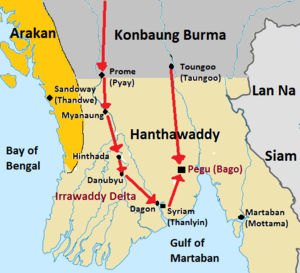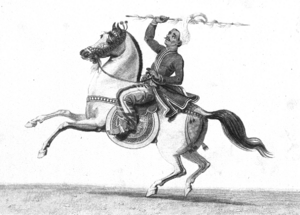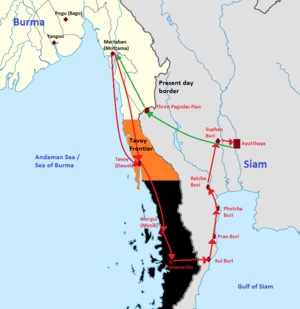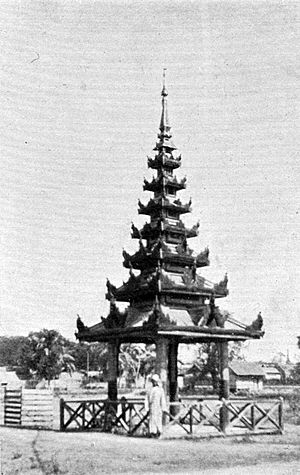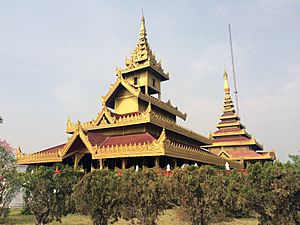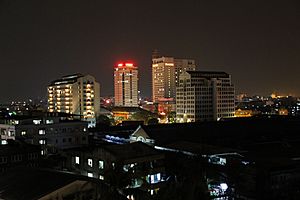Alaungpaya facts for kids
Quick facts for kids Alaungpayaအလောင်းဘုရား |
|||||
|---|---|---|---|---|---|
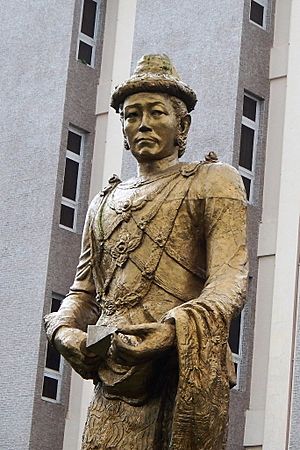
Statue of Alaungpaya in front of the National Museum, Yangon
|
|||||
| King of Burma | |||||
| Reign | 29 February 1752 – 11 May 1760 | ||||
| Coronation | 17 April 1752 | ||||
| Predecessor | Mahadhammaraza Dipadi | ||||
| Successor | Naungdawgyi | ||||
| Born | 24 August [O.S. 13 August] 1714 Friday, 1st waning of Tawthalin 1076 ME Moksobo |
||||
| Died | 11 May 1760 (aged 45) Sunday, 12th waning of Kason 1122 ME Kinywa, Martaban |
||||
| Burial | May 1760 Shwebo |
||||
| Spouse | Yun San | ||||
| Issue among others... |
Naungdawgyi Hsinbyushin Bodawpaya |
||||
|
|||||
| House | Konbaung | ||||
| Father | Min Nyo San | ||||
| Mother | Saw Nyein Oo | ||||
| Religion | Theravada Buddhism | ||||
Alaungpaya (Burmese: အလောင်းဘုရား, pronounced: [ʔəláʊɰ̃ pʰəjá]; also spelled Alaunghpaya) was the founder of the Konbaung Dynasty of Burma (Myanmar). He started as a chief of a small village. By the time he died from illness, he had united Burma. He also defeated the French and the British forces. He is known for adding new settlements around Dagon, which he renamed Yangon.
Alaungpaya is seen as one of the three greatest kings of Burma. He is honored alongside Anawrahta and Bayinnaung. He unified Burma for the third time in its history.
Contents
Who Was Alaungpaya?
The future king was born Aung Zeya (အောင်ဇေယျ, meaning "Victorious Victory"). He was born in a village called Moksobo on August 24, 1714. His parents were Min Nyo San and Saw Nyein Oo. His family had managed the Mu Valley area for many years. His father was the chief of Moksobo. His uncle was the lord of the Mu Valley District.
In 1730, Alaungpaya married his cousin, Yun San. She was the daughter of a chief from a nearby village. They had six sons and three daughters.
Becoming a Leader
Aung Zeya grew up when the Taungoo Dynasty was losing its power. The kings in Ava could not protect the country from attacks by the Manipuri people. These attackers raided Upper Burma often, starting in 1724. Ava also failed to get back southern Lanna and prevent the Qing dynasty from taking northern Shan States.
The Mu Valley, where Aung Zeya lived, was directly in the path of these raids. The people felt helpless as villages were burned and people were captured. In these difficult times, Aung Zeya stepped forward. He became the chief of his village in his early twenties. He was a tall and strong man. He showed natural leadership skills. Other local leaders saw him as their guide. They started to defend their lands themselves.
In 1736, the commander of Ava's army called Aung Zeya to Ava. He wanted to see if Aung Zeya was a threat to the king. The commander was satisfied that Aung Zeya had no plans for the throne. He gave Aung Zeya the title Bala Nanda Kyaw. Aung Zeya became a deputy to his uncle, the lord of Mu Valley. He was in charge of collecting taxes and keeping order.
Founding the Konbaung Dynasty
The power of Ava continued to weaken. In 1740, the Mon people in Lower Burma broke away. They formed the Restored Hanthawaddy Kingdom with its capital at Bago. Ava's attempts to get the south back failed. Fighting between Ava and Bago continued until 1751. Then, Bago launched a full attack on Upper Burma. By early 1752, Hanthawaddy forces reached Ava. They had help from French weapons and European soldiers.
The Hanthawaddy leader asked all officers in Upper Burma to surrender. Some agreed, but Aung Zeya chose to fight back. Aung Zeya convinced 46 villages in the Mu Valley to join him. On February 29, 1752, as Hanthawaddy forces were about to take Ava, Aung Zeya declared himself king. He took the royal name Alaungpaya, meaning "One Who Is the Future Buddha." This marked the start of the Konbaung Dynasty.
Not everyone believed in him. After Ava fell on March 23, 1752, Alaungpaya's own father told him to surrender. He said that even though Alaungpaya had many eager men, they had few weapons. Their small fort could not stand against the strong Hanthawaddy army. But Alaungpaya was determined. He said, "When fighting for your country, it matters little whether there are few or many. What does matter is that your comrades have true hearts and strong arms." He prepared his village, now called Shwebo, for defense. He built a moat and cleared the area around it.
Uniting Burma (1752–1759)
At first, many groups resisted the Hanthawaddy forces in Upper Burma. The Hanthawaddy command thought capturing Ava meant they had won. So, they sent most of their army back to Bago. They left only a small force to finish the job.
Alaungpaya's forces quickly defeated the first two Hanthawaddy groups sent to make him surrender. Then, they survived a month-long siege by a large Hanthawaddy army. They drove the invaders away. News of his success spread. Soon, Alaungpaya gathered a large army from the Mu Valley and beyond. Many other resistance groups and former soldiers joined him. By October 1752, he had become the main challenger to Hanthawaddy. He drove out all Hanthawaddy forces north of Ava.
Bago did not send more soldiers, even as Alaungpaya grew stronger. On January 3, 1754, Konbaung forces took back Ava. Alaungpaya now received respect from nearby Shan States. In March 1754, Hanthawaddy finally sent its entire army. They besieged Ava and advanced close to Shwebo. Alaungpaya personally led the Konbaung counterattack. By May, he had driven out the southern armies.
Conquering Lower Burma (1755–1757)
The conflict became more about ethnic groups, between the Bamar people in the north and the Mon people in the south. The Hanthawaddy leaders started to treat southern Bamars badly. They also killed the captured king of Taungoo in October 1754. Alaungpaya used this to his advantage. He encouraged Bamar soldiers to join him, and many did.
With more soldiers from all over Upper Burma, Alaungpaya launched a huge attack on Lower Burma in January 1755. By May, his armies had taken over the entire Irrawaddy Delta. They captured Dagon, which Alaungpaya renamed Yangon. However, his advance stopped at the city of Thanlyin, which was defended by the French.
Alaungpaya tried to make an alliance with the East India Company for weapons. But no help came. Konbaung forces finally took Thanlyin after a 14-month siege in July 1756. This ended the French involvement in the war. The Konbaung forces then defeated the Hanthawaddy defenses. They captured Bago in May 1757. The 17-year-old kingdom was finished. After this, Chiang Mai and other states in Thailand sent tribute to Alaungpaya.
Expanding to Shan States (1758–1759)
In 1758, Alaungpaya sent an army to the northern Shan and Tai states. These areas had been taken by the Qing dynasty since the 1730s. By early 1759, the Burmese had successfully brought these areas back under their control.
Cape Negrais (1759)
Alaungpaya then focused on the East India Company (EIC) outpost at Cape Negrais. The British had set up a fort there in 1753. During the war with Hanthawaddy, Alaungpaya offered to give the island to the British for military help. But the British refused, saying they were busy with their own war against the French. In 1758, Alaungpaya heard that the EIC had sold weapons to Mon rebels. On October 6, 1759, a Konbaung army of 2000 soldiers took over the fort. They destroyed it before leaving.
Wars with Other Countries
Manipur (1756, 1758)
Alaungpaya had seen Manipuri raids destroy his home region for years. He was determined to get revenge. While most of his forces were fighting in Syriam, he sent an army to Manipur. In early 1756, the Burmese army defeated the Manipuri army and raided the whole country. The Manipuris call this the First Devastation.
After Lower Burma was defeated, Alaungpaya himself led another expedition in November 1758. This time, he wanted to place a Burmese-supported ruler on the Manipuri throne. His armies invaded through the Khumbat route. They faced strong resistance at Pallel but eventually entered Imphal, the Manipuri capital, without a fight. The Konbaung armies caused great damage to the people. But historian GE Harvey says Alaungpaya "was only doing unto them as they had done unto his people". Alaungpaya put his chosen ruler on the throne. He also brought back many Manipuri horsemen. These horsemen became an important part of the Burmese army, known as Cassay Horse.
Siam (1759–1760)
The Ayutthaya Kingdom in Siam was one of the richest and most diverse places in Southeast Asia. For over 150 years, Siam and Burma had been mostly peaceful. But the Konbaung dynasty wanted to gain Ayutthaya's wealth.
Siam and Burma had often fought over the Tenasserim region. Burma controlled the northern ports, while Siam controlled the southern ones. Ayutthaya supported Mon rebels against Upper Burma. This encouraged Alaungpaya to attack Ayutthaya. He wanted to end Ayutthaya as a strong opponent and expand his empire.
Siege of Ayutthaya
After the rainy season of 1759, Alaungpaya's armies went back to the south. They needed to deal with the still-unstable Lower Burma. A big Mon rebellion had broken out earlier, briefly driving out the Konbaung governor of Pegu. Siam was giving shelter to the rebel leaders. Alaungpaya asked the Siamese king not to interfere and to hand over the rebels. But the Siamese king refused and prepared for war.
In December 1759, Alaungpaya's army of 40,000 soldiers left Martaban to invade Siam. His second son, Hsinbyushin, was his second-in-command. The Burmese took the town of Tenasserim. They moved east over the Tenasserim Hills to the Gulf of Siam. Then they turned north and captured coastal towns like Kuwi, Pran Buri, and Phetchaburi. The Siamese fought harder as the Burmese neared the capital of Ayutthaya. But they were pushed back with heavy losses.
The Burmese armies reached Ayutthaya in April 1760. But only five days into the siege, Alaungpaya suddenly became ill. Thai stories say he was hurt by a cannon explosion. However, Burmese sources clearly state he fell ill. His sickness was described as "dysentery" or "scrofula."
The Burmese began their retreat on April 17, 1760. Only 6,000 men and 500 Manipuri cavalry stayed behind as the rearguard. They successfully fought off Siamese attacks during the retreat. Even though the Burmese did not conquer Ayutthaya, they officially took control of the upper Tenasserim coast.
Death of Alaungpaya
Alaungpaya died on Sunday, May 11, 1760, near Martaban. He was being rushed back from the Siamese front. He had wished to see his home, Shwebo, one last time, but he did not make it. His death was announced in Yangon. His body was taken upstream on a royal boat. At Kyaukmyaung, near Shwebo, the entire court met the boat. They carried his body through the Hlaingtha Gate of Shwebo. He was buried with royal ceremonies in the palace city, which had once been his small village. He had ruled for only eight years and was not yet 46 when he died. Historian Harvey wrote that "men are remembered by the years they use, not by the years they last."
Alaungpaya was followed by his oldest son, Naungdawgyi. This happened even though his second son, Hsinbyushin, tried to take the throne.
How He Ruled
Government Changes
Alaungpaya spent most of his time fighting wars. For the areas he conquered, he mostly continued the rules of earlier kings. A key change was reducing the number of hereditary viceroys. He knew that having too many powerful family leaders could cause problems. So, he appointed governors in most new areas in the Irrawaddy valley. Many existing governors kept their jobs if they surrendered peacefully. Most Mon governors in the south stayed in power. He only appointed three viceroys, and none of these positions were passed down through families. For example, the viceroy of Taungoo was his younger brother. After these men died, their positions became regular governorships. He only allowed hereditary viceroys in distant regions like the Shan States.
One important new policy Alaungpaya started was setting up military and civilian settlements in Lower Burma. This policy helped the Bamar culture become more dominant by the early 1800s.
Building Projects
Most of his non-military work happened during short breaks from fighting. In 1752, he made Shwebo the capital of his kingdom. He made the small village into a large city. He built a palace there, like those of ancient kings. In 1758, he built the Mahananda Lake to provide water to Shwebo. He also built canals from the Mu river for farming, but this work was not kept up after his death.
His most lasting achievement was founding Yangon. After he conquered the town of Dagon in 1755, he added new settlements with people from his home region. Many place names in Yangon today still come from the Mu-valley. By the time of the First Anglo-Burmese War, Yangon had become the main port city, replacing Syriam (Thanlyin).
Justice System
For the law, in 1755 he ordered the creation of the Manu Kye dhammathat. This was a collection of existing laws, customs, and past legal decisions. Even though it was not perfectly organized, it became very popular. This was because it covered many topics and was written in simple Burmese.
Leadership Style
Alaungpaya was a very inspiring military leader. He motivated his people to achieve great things. He was generous with praise and rewards. But he was also strict when there were failures. People felt they could not fail when he led them. Being recognized by him was a great honor.
His Legacy
Rise of the Konbaung Dynasty
Alaungpaya's most important legacy was bringing back central rule to Burma after forty years. He also started the Konbaung Dynasty. Historian Htin Aung said that Alaungpaya led a people who were "divided and broken, humiliated and ashamed." He left his successors "a people united and confident, holding up their heads again in pride and in glory." However, Htin Aung also noted that Alaungpaya "had led his people in waging war but his leadership was still sorely needed to wage a peace." The Konbaung kings who came after him continued to fight wars with their neighbors. They built the second-largest Burmese empire, until they were defeated by the British.
Impact on Ethnic Identity
Alaungpaya has been seen as the first king to use ethnic identity to gain power. Some Mon historians blame him for the destruction of the Mon country. They say he ended centuries of Mon power in Lower Burma.
However, historians also point out that Alaungpaya was reacting to the policies of the Restored Hanthawaddy kingdom. This kingdom had started treating Bamars in the south badly since 1740. They saw themselves as a Mon kingdom and wanted the Burman north to be under their control. About 8,000 Bamars were killed in 1740. After killing many captives in 1754, the Hanthawaddy leaders made all Bamars wear a special earring and cut their hair in Mon style to show loyalty. While Alaungpaya was harsh in his attacks on Thanlyin and Bago, he also allowed Mon governors who surrendered to keep their positions.
Overall, Alaungpaya ruled Lower Burma for less than two years. Most of that time, he was fighting elsewhere. It was the later Konbaung kings who continued to suppress Mon culture after several rebellions.
How He Is Remembered
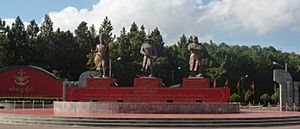
Alaungpaya is considered one of the three greatest Burmese kings. He founded the Third Burmese Empire. The other two are Anawrahta and Bayinnaung, who founded the First and Second Empires.
- Team Alaungpaya is one of the five student teams in Burmese schools.
- A statue of Alaungpaya is one of three statues of kings in Naypyidaw square. The others are Anawrahta and Bayinnaung.
- A statue of Alaungpaya is also in front of the Defence Services Academy.
- The UMS Aung Zeya is a ship in the Myanmar Navy.
- The Aung Zeya Bridge is a suspension bridge in Yangon.
- Aung Zeya Road is a road in Yangon.
- The Golden Letter of King Alaungpaya to King George II of Great Britain, from May 7, 1756, is on the UNESCO Memory of the World register. It is a proposal for trade between the two countries. It is engraved on a pure gold leaf with 24 rubies. It is the only surviving golden letter from Burma.
Family
Consorts
- Me Yun San, Chief Queen
- Shin Pyei
- Shin Min Du
- Thida Mahay
- Shin Kla
- Shin Shwe Kho Gyi
- Shin Shwe Kho Gale
Sons
- Naungdawgyi, 1734–1763
- Hsinbyushin, 1736–1776
- Amyint Mintha, 1743–1777
- Bodawpaya, 1745–1819
- Pakhan Mintha, 1749–1802
- Sitha Mintha, 1753–1782
- Pindale Mintha, 1754–1785
- Myingun Mintha, died 1804
- Kodaw-gyi, died young
- Myawaddy Mintha, died 1792
Daughters
- Khin Myat Hla, died young
- Me Tha, Sri Maha Mangala Devi, Princess of Kanni, born 1738
- Me Myat Hla, 1745–1788
- Me Sin, Princess of Bago, 1747–1767
- Me Minkhaung, Princess of Pandaung
- Min Shwe Hmya, Princess of Zindaw, born 1754
- Me Nyo Mya, Princess of Pin
See also
 In Spanish: Alaungpaya para niños
In Spanish: Alaungpaya para niños


